What Writing Over 600 Articles Has Taught Me About Blogging
Writing 600 articles have taught me a lot. Not only has it given me a ton of information and knowledge about the subjects I am writing about, it has also improved my writing dramatically.
When I look at some of my first blog posts, I cringe my face out of embarrassment due to the extremely low-quality writing. My first blog posts basically did everything that your blog-writing guide tells you not to do.
A headline that doesn’t even catch the attention and interest of a 5-year-old, images that have absolutely nothing to do with the actual content that I am putting out, and last but not least, a big block of text presented in the most un-digestible way possible.
But who can I blame? We all start out as beginners at some point. And it is the learning and improvement process that is the beauty of writing.
Think about the person in your industry that you look up to right now.
Maybe it is the person who can catch your interest with their amazing written content or someone who have created the habit and speed of writing 2 blog posts a day.
Got it?
Good.
The person you aspire to become was just as confused when starting out as you were (or are)- and me too!
Now, I am no expert in writing, but I think it’s safe to say that I am a lot more experienced than I was before I started writing. And that’s what matters – self-improvement.
1. Execution is what teaches you
Books and studying can only teach you so much. Studying and being hungry to always learn is essential for improving your writing, but it is the execution of actually writing that will give you knowledge that no book can teach you.
Entrepreneur Gary Vaynerchuk puts it this way: “Go do it. You can only read so much. You have to do. How many books from these fucking experts do you need? do shit”

While my words wouldn’t sound like that, they are so true, because that’s the method I use to improve my writing.
Every time you write, you improve. You speed up your writing, you learn what words are good to use, what structure you need to have in order to make the information you are presenting as easily-readable and digestible as possible.
This is only achieved by actually doing.
I am so glad I learned that at an early stage of my writing because it has allowed me to improve dramatically. if you look at my first posts and my latest posts, they look like they come from completely different worlds.
As the number of written articles increase, you’ll be able to see the quality of them improving as well.
Blogging and writing are like any skill you have to develop. It demands real-life practice. You can study and read about how you ride a bicycle all you want, but if you never actually do it, you’ll never learn!
Is reading and studying helpful?
Sure!
I am constantly reading and learning, but that part should never be done at the expense of writing.
If you have to choose between writing or studying, you should choose writing every time.
2. Break up your content
Every single blog post you write needs to be skimmable.
Most readers are skimmers. In fact, readers only read an average of 20-28% of a post, even if they like it. When I learned that, my mind was blown. Well, not really blown, but I was intrigued to learning what I could do differently in order to change that number for better.
That’s when I “found out” the different ways of breaking up my content.
Or more like “Realized that I need to use them”.
Before this, most of my content included a few walls of text, and not much more – believe it or not.
I know, I was that stupid.
Breaking up your content is vital to getting people to actually read it. No matter how good of a writer you are, nobody wants to read a wall of text.
It’s boring.
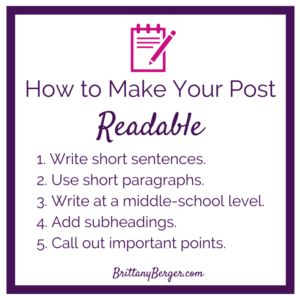
Here’s the deal:
I learned the importance of making articles scan- and skimmable from people who were more experienced than me, and this is a great example of how studying is helpful, and how you can improve your writing by learning from other, more experienced writers.
There’s a catch…
Again, studying and learning from others is important, but it is what you do after, with the knowledge you gain that really matters.
If I wouldn’t execute the things that I learn from others, what would be the point?
Things started happening when I put the knowledge into practice and did what Gary would have described as “Fucking did”.
“Knowlege is worth nothing unless it’s used”
So, how can you break up your content and make it skimmable?
1. Lists
Most people tend to find lists much easier to read than normal text.
Lists can be created both bullet points or numbered points. Using them both helps add variation to your post and keep your audience interested.
If you read any successful blog, I can assure you that you’ll find lists on almost all of their posts.
Brian Dean, founder of Backlinko uses both bullet points and numbered lists in his blog posts to make it easily digestible and skimmable.
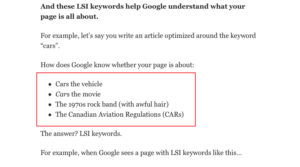
Lists do the following with your text:
- Present your points in a clear way
- Stands out from the rest of the text, giving your readers a break
- Makes your text more easily scannable
2. Subheads
Subheadings are the most common way to break a text into smaller chunks and often help categorize the text into big points and help you clearly transition from one subject to another.
Just like the title, the subheads help catch the reader’s attention and makes them continue reading.
3. Attention-grabbing transition words
This is my favorite way to break up my content, and that’s because it’s one of the most effective ways to keep my readers interested.
Attention-grabbing words are words or sentences that help convey the point I am trying to make, but in a way so that the reader will continue to read.
The best part?
You can use them too!
You see the question I asked right above?
That’s one example of attention-grabbing sentences or transition words.
When I first started writing, do you think I used them?
Nope, not a chance. I just wrote whatever crossed my mind and hope that people would have enough patience to keep reading. But as you probably have guessed, most people hadn’t.
Here are some of my favorite words and sentences I use in my posts:
- Here’s the deal
- There’s a catch…
- Look:
- Why does this matter?
- The best part?
- Want to know why?
- Why?
As you might have noticed, I’ve even used several of them in this article!
Why? Because they work! When writing, you want to use every technique possible to make your readers stay on your post, and this is a method that I have found to be very effective.
3. Use relevant images that bring value
When I started out, I was eager to study and learn what goes into writing a great blog post. Inevitably, I came across the fact that you should use at least one or two images in each of your blog posts.
Now, I know that images are incredibly important. But what’s even more important is the visuals you choose. If you implement images that don’t actually add value, you’ll end up harming the way people perceive your content, and how good people will think your article is after they’ve read it.
Nobody wants to read solely text. When people see a full page of text, a lot of them will get frightened and leave, some will stay, some will read the first the first few paragraphs, then realize that it’s way too hard to digest without images… and leave. And last but not least: some will read the whole thing – but very few.
What better way to explain how important visual content is in complement to the content you are writing can only be explained with proper statistics, so here’s a powerful one: The brain processes images 60,000 times faster than it does text.
Think about that!
The articles I read said that 1-2 images were essential for every single blog post.
So what did I do?
I did what they said…
Without thinking about what it really meant.
I implemented free images from photo-websites like Pixabay and added them to my articles where I thought was suitable.
The end result looked something like this:
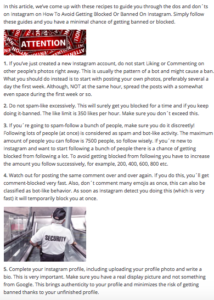
Funny, right?
Well, we live and we learn…
What I’ve learned over the course of my writing is that images significantly improves the reader experience, increases the retention rate, and decreases the bounce-rate, and it didn’t really come as a surprise after I learned the fact that I just presented to you above.
The importance of images does not only concern blog posts and articles. It concerns all type of written content that demands people’s attention.
After all, the average time of a human’s attention span is 8 seconds. That’s
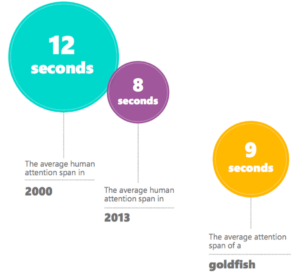
A study found that press releases without images had an average time on page of 2:18. In contrast, press releases with at least one image found that the average time on page was 2:47.
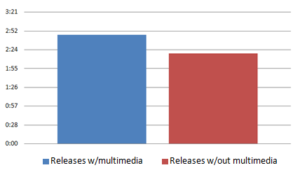
What did I learn from this?
Don’t add images just for the sake of adding them. If they don’t bring any value, you’ll be better off without them.
Adding relevant images that add value is difficult. Especially considering all the copyright you need to think of.
Thankfully, I haven’t learned the hard way.
I have found screenshots to be very helpful and value-providing in my articles, and often help make my point clearer.
4. Quality trumps quality
What also harmed the quality of my early-stage articles was that I thought “The more articles I blasted out, the better”.
But as with everything in life, quantity does not beat quality.
At most, I blasted out 9 articles a day (all equally lousy) and then waited for people to herd around my content.
Yep, you guessed it right.
They never did.
Writing one in-depth article with information that only you can provide is far more valuable than putting out 10 or even 20 mediocre ones.
5. Write short paragraphs
We’ve spoken about how important it is to avoid writing blocks of text and how I early on realized and learned that nobody likes to read them. This brings me to my next point.
The reason to why I wrote articles and blog posts with enormous paragraphs was probably because that was I was being taught in school.
I used it out of instinct because that was what had been etched into my brain for so many years.
And you know how hard it is to change something that you’ve done for so many years.
But in blogging, if you want to create amazing blog content, it’s essential that you re-teach yourself as fast as you possibly can.
“Walls of text builds walls between you and your audience”
We’ve also talked about how writing content with sub headings, bullet-points, lists
But another thing that is equally important is the length of your paragraphs.
When I first started out, I looked up every single blog I could find to see if there was anything I could learn, and that’s when I (Inevitably) came across Neil Patel’s blog.
He wrote blog posts in a way that was against everything that I’d been taught, but still, it seemed to work.
It amazed me so much that I had to study the case closely and see if there was anything that I could implement into my own writing.
And sure enough – there was!
What was it that he did that was so unique and interesting, you may ask?
It was the fact that he normally only wrote 2 or 3 sentences per paragraph. Sometimes only one. And sometimes even one word!
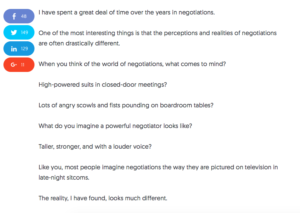
What did I find?
Thankfully, he had explained in an article why he chooses to make his paragraphs so short, and then, of course, it wasn’t so hard to figure out either.
It all plays on humans short attention-span. When you have completed reading a paragraph, you get a feel of satisfaction.
It’s not Neil that is the inventor of short sentences. In fact, several studies prove that short paragraphs tend to get read more than blocks of text. Sounds reasonable, right?
The study shows that if your average sentence length is 14 words, your readers will understand up to 90% of what you are saying. If you want your readers to get the full story, stick to just 8 words per sentence.
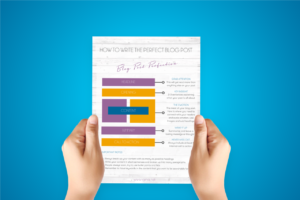
over 2 million blog posts per day alone, skimming is necessary. People skim to read the key points of an article to see if they are interested. If they are interested, they often go back and read the article more slowly.
6. Having a consistent posting schedule is vital
Almost every blogging guide recommends you to share content regularly.
They aren’t lying!
You really should.
This is one of few things I did right with my blogging already from the start. Because I was eager to start gaining traction, writing every day quickly became a habit. And if I didn’t have time to write a day, thankfully, I had written two posts the day before, so I could keep up my consistent posting schedule.
This is true still to this day. I am posting anew blog post every single day, and that’s because I’ve set my mind to it and decided to do so.
Will it be tough some days?
Definitely.
Will it be worth it?
Undoubtedly.
Will I fail some days?
Probably, but at least I tried!
The point is: decide on how often you are going to share a new post and stick to it. Your audience will expect yo to post X number of times this week if that’s what you have done for the last period of time. If you are posting once a week, great! Once a month awesome! Just make sure you do it regularly.
Consistency is key.
Conclusion
Improving at something takes time and consistency. No matter what it is you are doing.
Reading and studying is helpful and effective, but there’s nothing that beats execution. In order to improve your writing, execution is the real secret recipe.
What about you?
How long have you written for? What have you learned in the process?
I’d love to hear about it!



Brilliant post 😀
Thanks a lot Michele!
I apologize for off-topic, I’m considering about making an enlightening internet site for students. Will probably start with submitting interesting information like”A Boeing 747s wingspan is longer than the Wright brother’s first flight.”Please let me know if you know where I can find some related information and facts like here
http://essays80.blog5.net/8730682/essays-and-its-changing-aspects-of-importance-with-modernization
Tani waa waxa qiimaha qiimaha! 🙂